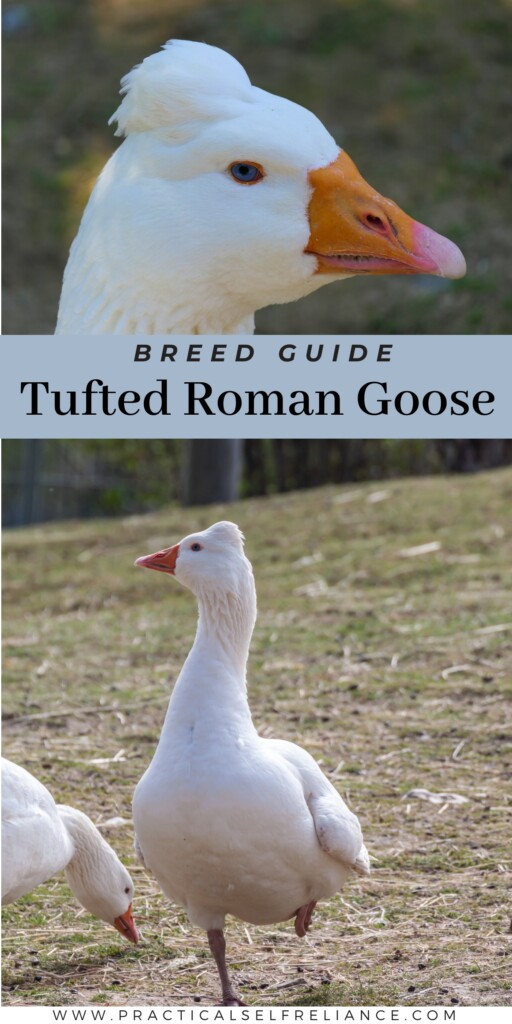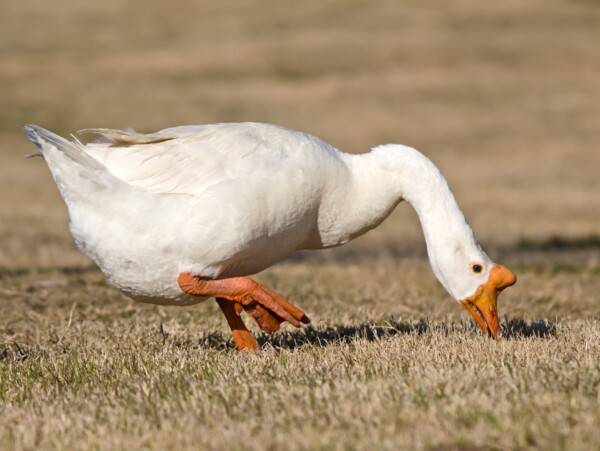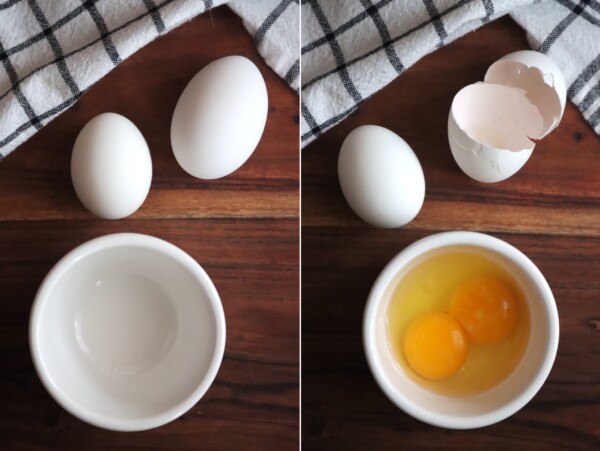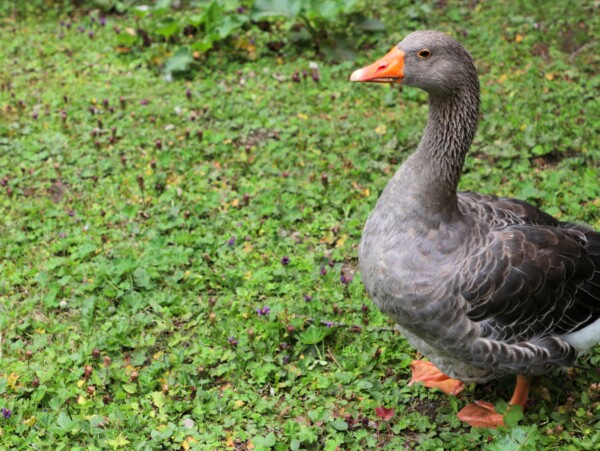Affiliate disclosure: This post may contain affiliate links. Please see our Privacy Policy.
Tufted Roman geese are compact, friendly birds with an elegant crest of feathers on their heads that gives them a touch of personality and charm. Despite their ornamental appearance, they’re one of the oldest known domestic goose breeds, dating back to the Roman Empire.
Bred for both practicality and beauty, these geese are perfect for backyard keepers who want a small, personable bird that’s easy to manage.
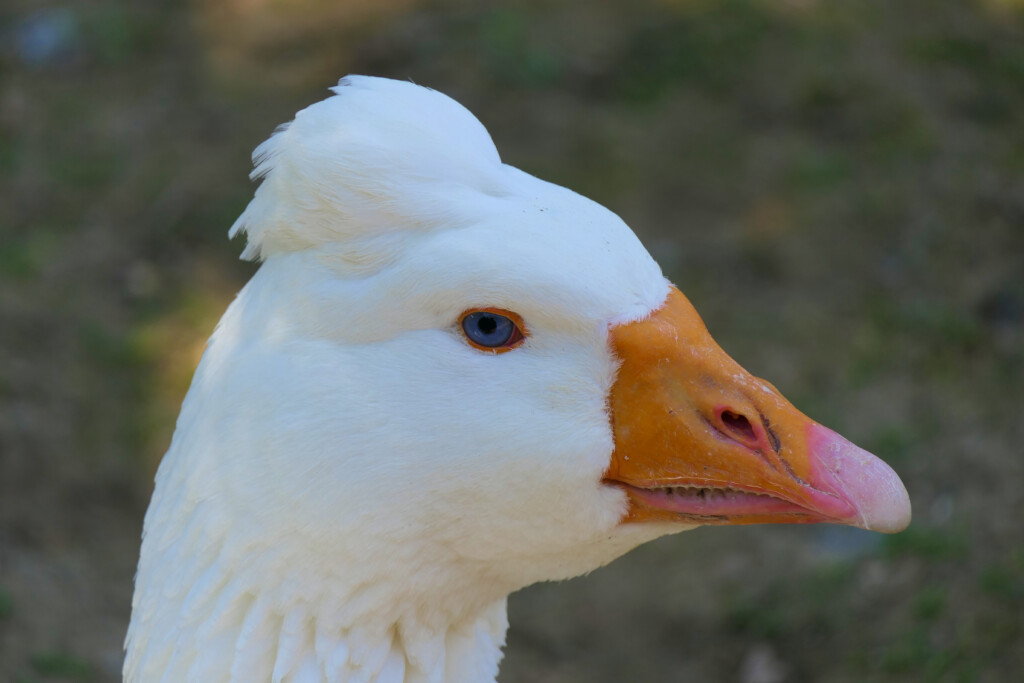
Table of Contents
We’re adding Tufted Romans to our flock this year because we wanted geese that were easygoing, lightweight, and less prone to drama during breeding season. I have young kids at home that absolutely love to snuggle our geese, and tufted Romans are some of the friendliest around (both goose and gander). They’re also known for being the most sociable breed of goose.
They’re confident but not aggressive, curious without being noisy, and more likely to waddle up to greet visitors than sound an alarm. With their small size and calm demeanor, they’re one of the best breeds for families with young children—or for anyone looking to raise geese without the chaos.
And, of course, the fun hair-do only ads to their appeal.
What Are Tufted Roman Geese?
The Roman goose is an ancient breed, believed to have originated in Italy and possibly descended from wild Greylag geese. Historically, they were used as both guard animals—famously credited with saving Rome from invaders—and as a source of meat and feathers. Over time, selective breeding in North America led to the development of the Tufted Roman, which features a soft puff of feathers atop the head. And, of course, a quieter disposition that’s much less of an alarm goose.
Tufted Romans are still relatively rare outside of exhibition circles but are gaining popularity on homesteads thanks to their calm nature, compact size, and striking appearance. They’re especially well-suited to suburban or small-space setups where a large, loud goose might be impractical.
Despite their ornamental features, they’re fully functional homestead birds—good foragers, moderate layers, and excellent at integrating into mixed poultry flocks.
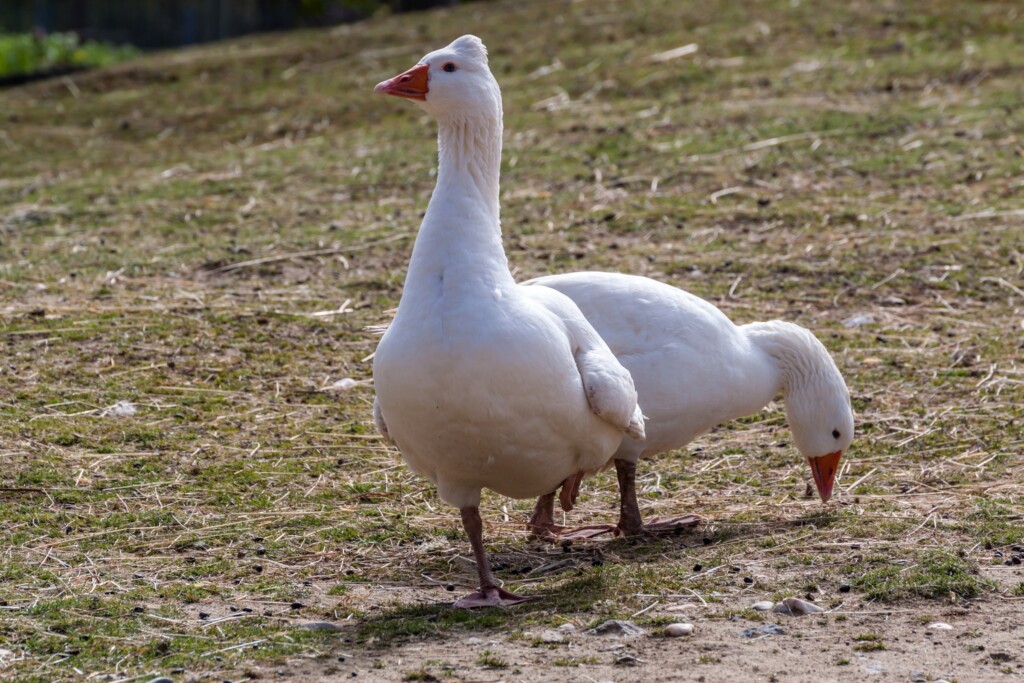
Pros and Cons of Tufted Roman Geese
Every animal has its own pros and cons, but for this breed, I think the pros far outweigh the cons!
Pros
- Calm and extremely people-friendly
- Small size makes them manageable in small spaces
- Adorable crest adds ornamental appeal
- Moderate egg production
- Cold and heat hardy
Cons
- Not a high meat yield breed
- Some lines have weak brooding instincts
- Tufts may be inconsistent in hatchery stock
- Harder to find than other white geese
Tufted Roman Goose Characteristics
Tufted Romans are one of the smallest standard-sized goose breeds. Ganders typically weigh 10–12 pounds, and geese weigh 8–10 pounds. Their bodies are compact and rounded, with a smooth white plumage, orange bills and legs, and the signature feather tuft that crowns the top of the head.
The tuft is most prominent in birds from exhibition lines but may be smaller or absent in hatchery stock. Either way, it adds a touch of charm and makes them easy to identify in a mixed flock. Because of their small size, they don’t require as much space or feed as heavier breeds—and they’re far less likely to damage garden beds or trample seedlings.
Roman geese also have a calm, gentle expression that reflects their temperament. They’re alert without being flighty, and social without being clingy.
- Breed Name: Tufted Roman Goose
- Breed Type: Ornamental, light utility
- Temperament: Calm, friendly, gentle
- Size: Light. Ganders ~10–12 lbs, Geese ~8–10 lbs
- Eggs Per Year: 20 to 35 eggs (seasonal)
- Egg Size: Medium to large
- Egg Color: White
- Lifespan: 12 to 18 years
- Time to Maturity: 20–24 weeks
Tufted Roman Goose Breed Standard
Roman geese have short, rounded bodies with a compact, well-proportioned build. Their necks are slightly arched, and their posture is upright but not overly tall. Their eyes are blue, and they have a gentle, inquisitive expression.
The defining characteristic of the Tufted Roman is, of course, the head tuft—a small crest of feathers that can range from a neat puff to a full, feathery crown. While the tuft doesn’t serve any functional purpose, it gives the breed a signature look and contributes to their popularity in ornamental flocks.
Feathering is smooth and clean, and their all-white plumage is crisp and easy to spot in the pasture.
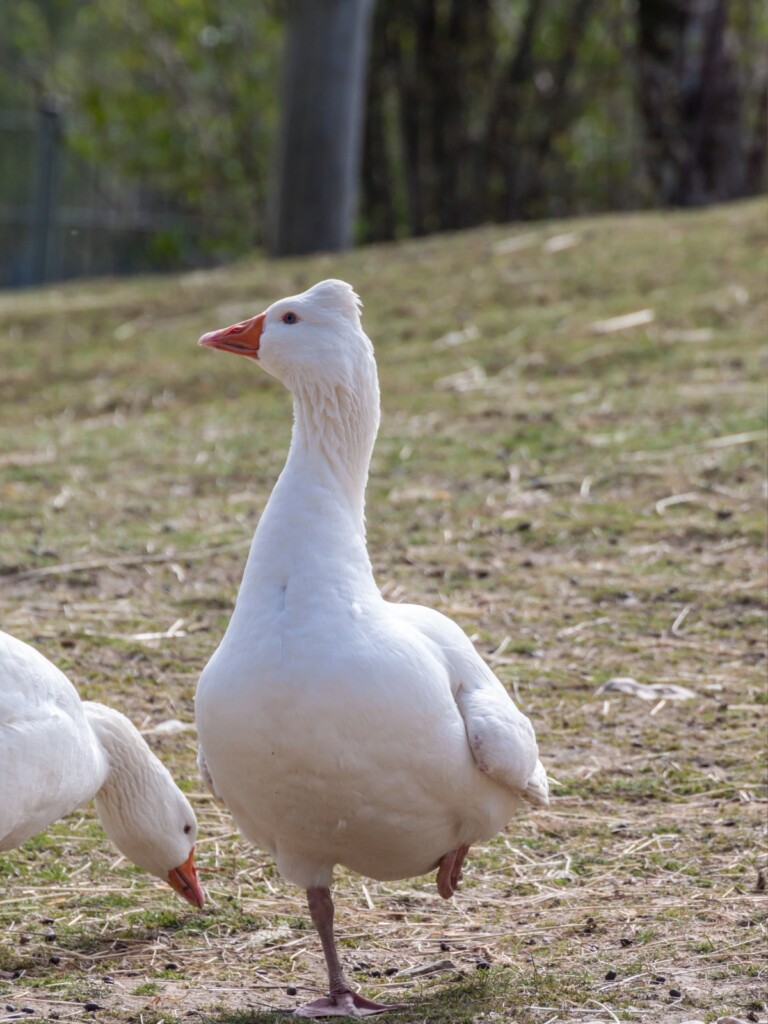
Temperament
Roman geese are among the calmest and most manageable goose breeds available. They rarely show aggression, even during the breeding season, and they’re often recommended for beginners and families. When raised with regular human interaction, they’re confident and curious without being pushy or demanding.
They don’t mind being handled, and they usually prefer to observe rather than flee when approached. Their voices are soft compared to most geese, and they rarely honk without reason.
If you’re looking for geese that won’t chase your kids—or your dog—the Tufted Roman is an excellent choice.
Hardiness
Tufted Romans are hardy birds that do well in a range of climates. They handle cold weather admirably, especially when provided with dry shelter and wind protection. Their dense down keeps them insulated in snowy conditions, and their compact bodies help them retain heat.
They’re also quite heat-tolerant, provided they have shade and access to water for bathing. Their feathers are waterproof and self-maintaining, and they don’t require any special care beyond what you’d give other geese.
They’re a great all-around breed for year-round outdoor keeping.
Egg Production
Tufted Roman geese are moderate layers, producing around 20 to 35 white eggs per year. Laying begins in early spring and continues into early summer. Eggs are a bit smaller than those from heavier breeds but still large by poultry standards and excellent for baking or hatching.
Hens may or may not go broody—some lines have stronger maternal instincts than others. When they do set, they’re attentive mothers and generally raise goslings well.
Even if you’re not breeding, the eggs are a nice seasonal bonus from a breed often kept just for looks and personality.
Egg Color
Eggs are white with smooth, strong shells and rich yolks. They weigh between 4 and 6 ounces depending on the bird and the point in the laying season.
Like most geese, Tufted Romans prefer quiet, hidden nesting spots and may lay in secluded corners or tucked-away shelter boxes.
Meat
While not a heavy meat bird, the Tufted Roman goose still produces a flavorful, lean carcass suitable for roasting. The meat is darker than chicken and has a rich, gamey flavor typical of goose.
They dress out best around 5 to 6 months and are easier to pluck than curly-feathered breeds like Sebastopols. While you won’t get the volume of meat from a Roman that you’d get from a Toulouse or Embden, they’re a good option for small homesteads where space or feed budget is limited.
Broodiness
Broodiness varies by line. Some Tufted Roman hens will set faithfully and raise goslings with little help, while others may lose interest midway through incubation.
When hens do go broody, they’re generally calm and focused—and they often make excellent mothers if given privacy and protection from predators. If you’re planning to breed, it’s worth selecting hens from lines known for strong maternal traits.
Artificial incubation is easy with their eggs and offers a good backup plan for inconsistent brooding.
Foraging Ability
Tufted Roman geese are efficient grazers despite their small size. They cover less ground than larger geese but are active and curious, making them excellent for smaller pastures, orchards, or garden borders.
Because they’re lighter, they’re less likely to damage sensitive ground or trample crops. They’re a great choice for “weed patrol” or grass maintenance in compact homestead setups.
In warm months, they can meet most of their nutritional needs through pasture alone.
Cross Breeds
Tufted Romans are sometimes crossed with Buff or Pilgrim geese to add crests to otherwise utility-focused birds. The tuft is a dominant trait, so it often appears in the first generation of crosses.
These birds retain the Roman’s calm nature and are often more ornamental than productive, but make great additions to mixed flocks and smaller properties.
Common Health Issues
Tufted Romans are healthy birds overall, but as with any compact breed, there are a few things to watch for:
- Watch for lice or mites in bedding areas
- Protect tufts from frostbite in very cold weather
- Provide dry shelter to prevent respiratory issues in wet seasons
Otherwise, they’re robust, self-sufficient, and easy to manage with standard care.
Tips for Raising Tufted Roman Geese
Handle goslings early and often to encourage tame adults. Provide low-sided nest boxes with soft bedding to keep eggs and tufts clean. Rotate pasture areas to keep ground fresh and avoid parasite buildup.
Keep a shallow tub or kiddie pool available for bathing—Romans enjoy a daily splash but don’t require deep swimming areas.
Tufts are generally low-maintenance, but avoid snagging or frost damage by offering overhead protection during winter storms.
Tufted Roman Goose FAQ
Yes—one of the calmest and most people-friendly goose breeds. Excellent for beginners and families.
Ganders weigh 10–12 pounds, geese 8–10 pounds.
Yes—expect 20 to 35 eggs per year, mostly in spring.
Some tufted roman geese are excellent mothers, though broodiness varies.
Not particularly. They’re among the quieter goose breeds.
Yes—provided they have dry shelter and bedding, but that’s true of most goose breeds.
Absolutely. Their size and temperament make them ideal for smaller backyards or urban homesteads. That said, geese don’t do well in actual confinement, so they’ll still need a reasonable yard (not just a coop).
